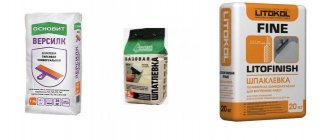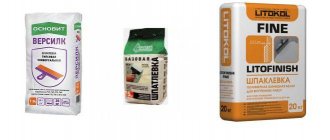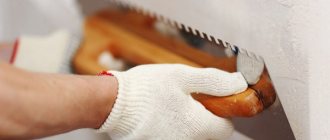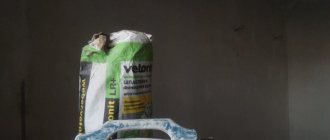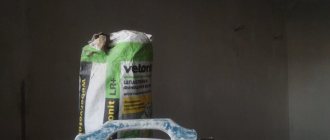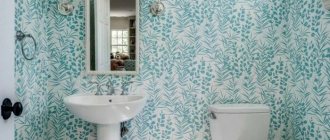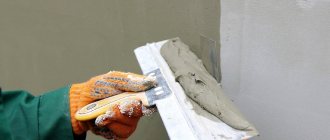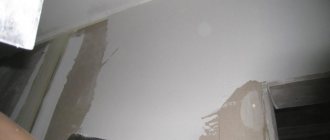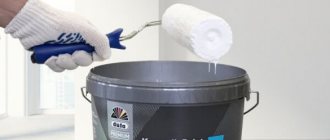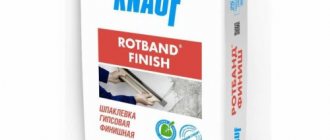Types of putty
The main difference between finishing coatings is their composition. The following types of plasters are available for sale:
- Gypsum is the most common type. It is often chosen by contractors because it is very easy to use. In addition, you can permanently correct the surface, which makes work easier, and get perfectly smooth walls and ceilings. It is also an ideal putty for plaster;
- Cement and cement-lime have a coarser grain size than gypsum, and therefore do not provide such a smooth surface. In addition, they are more difficult to use. However, they are more resistant to moisture and mechanical damage than gypsum;
- Limestone and gypsum-lime - designed for leveling walls finished with lime or gypsum-lime plasters. Like gypsum finishes, they should not be used in wet areas;
- Polymers are easier to apply and process than gypsum finishes. They provide a very smooth surface. They can be used for finishing partitions in rooms with high levels of humidity, like putty on wood.
Finishing putty WEBER-VETONIT KR - reviews
Konstantin
I am writing about my impressions of Weber Vetonit putty. I saw their bright yellow bags a long time ago, and the other day I realized that I was purchasing it for the third project in a row. The materials show themselves well, and the hands themselves stretch out. I usually use Weber for floors, but here I used finishing putty for walls. It is white, matte. It's easy enough to knead. I haven’t puttyed the walls myself, but the crew has good reviews, they say it’s easy to putty, you can remove a fairly thin layer, which I can see myself. The resulting walls are smooth and pleasant to the touch; they do not generate dust or glare. Painting such walls is a real pleasure. Everyone can see what the money was paid for)
Leonid
I liked that the putty was white. For us, this turned out to be very convenient in further repairs with a rather complex design. We did the repairs ourselves, and a friend, a builder, also helped us, who advised us to take Weber Venonit KR. The first time I mixed and applied it together with a friend, and then I was able to do it on my own. It was easy to apply, the consumption corresponds to the declared one, which, to be honest, I did not expect. We waited until it dried, the final surface was good, we were happy with it, the paint applied well. If my wife wants to experiment some more, I think I’ll use the same material again.
staleb
https://otzovik.com/review_2507088.html
Advantages:
I only use it
Flaws:
no cons
I have been doing painting work for many years and I can say that this putty is of excellent quality since it covers all surfaces evenly, has good elasticity and is not difficult to sand, unlike other mixtures.
abcand1
https://otzovik.com/review_5924689.html
Advantages:
Inexpensive, flexible, easy to apply and sand.
Flaws:
Didn't reveal
At one time, when making repairs, when I had to earn a living from this, I used this putty very often. Both I and the customers were always satisfied. In fact, this composition can easily level any surface and by grinding you can bring the quality to ideal. After reading the negative reviews, of which there are many in this section, I decided to write my own to dilute the negative. Lime-based putty with the addition of organic glue. The putty is suitable for leveling walls and ceilings in residential areas for wallpaper or painting. I know apartments that I renovated back in 2004 and still nothing has been washed away or crumbled there. Wallpaper hangs on the walls, paint lies on the slopes. Maybe it’s a matter of non-compliance with technology, but that’s a completely different question. Of course, it is not waterproof, which is what it says on the packaging. Why do many people write - “it is washed off during subsequent priming, crumbles after six months, and becomes white.” If you need to use putty in damp rooms, take
VH, if you need it stronger and to avoid whitening, use polymer
LR+. They also have a different price. In addition, with the help of lime putty you can create a vapor-permeable coating, which can be important when using some building materials. In general, it’s a normal putty, you just need to remember that “every vegetable has its place in the garden...”
yljana333
https://otzovik.com/review_3453535.html
Advantages:
looks good, easy to work with, can be cleaned with either a dry or wet cloth, can be made into different textures and is good for painting
Flaws:
cracks when the layer is thick, there is a slight smell in the room
I'm not a builder, but we tried many options when doing renovations. I liked this Weber-Vetonit KR putty the most. We created texture on the walls. After applying it to the walls, I waited 5 minutes and went over it with a roller. The result was a soft texture that did not scratch. Which is important to me because we have a child. Then they painted it. It looks just great. No worse than more expensive analogues. It washes off perfectly from surfaces that you have touched and from working tools. Doesn't harden quickly. This allows you to finish the work later. Evens out minor defects on walls. But if the layer is thick it may crack. For example, it’s better not to seal the seams.
MT77
https://otzovik.com/review_2750400.html
Advantages:
Easy to use
Flaws:
No
I recommend everyone to use this putty. There is a lot of choice on the building materials market, but this is one option where you won't be disappointed. It mixes easily, you can choose any consistency that is convenient for you to work with. It is elastic, efficiently levels the surface and, most importantly, can be sanded perfectly. Of course, you need to buy such a mixture in construction stores. Inspect the bag and make sure it has not been stored wet. In such cases, dried stains remain on the bag. If there are any, refuse such a purchase. If stored improperly, the putty loses its quality.
Linkin Park
https://otzovik.com/review_3157128.html
Advantages:
Easy to use
Flaws:
Not very strong.
Having been involved in repairs for more than 10 years, I can no longer imagine finishing putty without vetonite. Very convenient for puttying, excellent mixing of layers, the diluted mixture has a very high viability, can last 5 days in a closed container and will be suitable for further use. Sanding the putty surface does not cause any special problems; it is leveled easily and evenly. When priming with a brush, it blurs a little, so we usually prime with a spray gun. So, when comparing with other putties of a similar type, we have long chosen Vetonite, which is what we wish for you. The only thing that confuses some is the price, which is higher than other analogues.
Papaw
https://otzovik.com/review_3271586.html
Advantages:
Quality, reliability.
Flaws:
Not a very good smell.
Weber-Vetonit KR putty. It is very easy to use, it is very easy to stir and apply to walls or ceilings. Suitable for interior work. Both puttying for wallpaper and painting. It is easy to sand and does not take much time to work.
Lipeshko
https://irecommend.ru/content/otlichnaya-smes-plokhomu-tantsoru-vsegda-chto-meshaet
Putties from are the most convenient to use. But choose the right type of putty for your tasks. The binder of this mixture is organic glue, this is what causes the specific smell from the raw material, which disappears after drying, approximately on the second day, depending on the layer.
The mixture is easy to knead and does not form lumps or clots. Depending on the thickness of the application, you can make it a little thinner or a little thicker. In fact, it can be stored for up to a week if you use filtered or boiled water. If you take tap water, soak the mixture within two days, after which it will go rancid. The water for mixing must be warm; the mixture should also be kept warm, in the range from +8 to +15 degrees.
The mixture is not moisture resistant, but much stronger and cheaper than the popular one "
Vetonit Lr+". It is quite easy to process, but it must be done within two days after drying. To increase the strength of the mixture, part of the water can be replaced with a proprietary liquid from Vetonit; in fact, you can add carpentry PVA to the water, but do not overdo it.
Ideal for walls, especially if repairs are not expensive and they were not aligned with beacons. Cannot be used under tiles or for leveling floors.
If this is your first time encountering this mixture, but you have already worked with gypsum or cement putties, there will be no difficulties in application. If you have no experience at all, apply thin layers in 2-3 passes, first completely drying each layer. But still, I always advise beginners to use
Lr+, and cover everything on top
Rotband with paste takes longer, but the result will please you for years.
Martynov Oleg
https://www.id4.ru/top/?r=shpatlevka&u=vetonit
One of the best putties. Both behave well at work. KR has a specific odor due to the organic binder, but it disappears if the room is ventilated after the layer has hardened, so it is only a matter of time. LR+ has already become a classic, the most optimal combination of price and quality. Usually we ask customers to buy only this putty; it applies perfectly, sands well and then sticks to the walls very firmly. Not a single complaint about the walls was received from customers.
KirSan
https://spreeloony.ru/gds/purchases/shpaklyovka-polimernaya-finishnaya-weber-vetonit-kr-4274
I purchased Weber Vetonit KR finishing polymer putty in the spring for the final finishing of the bathroom. A 20-kilogram bag in a Leroy Merlin store cost 388 rubles. It is made on the basis of organic glue, which will allow for a clean finishing of the walls. With a maximum grain size of just 0.3mm, it creates a smooth matte protective layer. It is necessary to carry out finishing work with this putty only in dry rooms. In rooms with a humid microclimate, it will not be possible to achieve the desired result. Consumption per 1 square meter is 1.2 kilograms. Since Vetonit KR putty is made on the basis of organic glue, it has one feature - an unpleasant odor. But after drying, it disappears, and you can begin further work. I am satisfied with the purchase.
Tatiana
https://stavropol.leroymerlin.ru/product/shpaklevka-polimernaya-finishnaya-weber-vetonit-kr-15909305/#nav-reviews
You can’t do without vetonite at the finish, the mixture is pliable for decorating walls - it’s just the thing +
Anna
https://stavropol.leroymerlin.ru/product/shpaklevka-polimernaya-finishnaya-weber-vetonit-kr-15909305/#nav-reviews
I used this putty in the hallway, excellent plasticity, ease of application and giving a pattern. The shelf life of the finished solution is 30 hours, and in a closed container up to 60 hours, which is good news; you don’t have to rush too much. Doesn't turn yellow like PROMOTIONERS. There is a slight smell of dog after drying, but it is not as disgusting as everyone here describes, after double priming the walls there was no smell or trace left, which is why everyone is indignant, I don’t understand, maybe they just don’t know how to work. The wall looks perfect. I recommend
Vasily T.
https://www.obi.ru/shpaklevki/shpaklevka-weber-vetonit-kr-na-organicheskoi-osnove-finishnaya-5-kg/p/2073765
A good basic putty for leveling walls. We used it to line the walls in almost the entire apartment (with the exception of the bathroom). And we were pleased with the result, especially considering that I did most of it myself without the help of a specialist, and this was my first time leveling the walls. As it turned out, polymer putties are much more convenient to use and easier to apply, so even a beginner can cope with leveling the walls.
Alexander
https://vesnavzvode.ru/product/57/
Pros:
Good white putty
Minuses:
No
Review:
I read a lot of reviews although I bought it earlier... before I read the reviews and I was not mistaken... today they putty on 3 walls, I came and smelled them specifically... it doesn’t stink... there is an almost imperceptible smell of drying and after 4 hours there is no trace of the smell left. Don’t write nonsense... you need to putty when the walls are thoroughly dry!!! And it is necessary to putty with good ventilation and at a temperature of +15-20 above 0
Vladimir
https://vesnavzvode.ru/product/57/
Pros:
Plastic, slippery, easy to sand
Minuses:
You have to wait until the base dries, it doesn’t like high humidity in the room
Review:
It must be applied to a dry base, then there will be no smell.
Form and method of application
Putties are offered in loose form for mixing with water or as a ready-to-use mass. The latter form is more convenient, and the use of such a product allows you to speed up the work.
Similar to another parameter - method of application. This can be manual or machine control using a unit. Machine application is much faster, especially for large surfaces.
- Traditional cement-lime putties are especially valued for their durability, but it is worth remembering their other advantages.
- Their very good adhesion makes them an ideal base for painting, as well as for all types of cladding, such as wallpaper or ceramic tiles.
- They are suitable for any interior and any conditions - for the kitchen, living room, corridor or children's room, and due to the fact that they are waterproof, also for rooms with humidity above 70%, such as bathrooms.
- Each putty has a minimum and maximum layer thickness specified by the manufacturer. Usually it is 2-3 mm.
It is also worth paying attention to the maximum allowable size of individual cavities. The standard is 3 mm, but you can also buy plaster that can be used to seal 20 or even 30 mm of unevenness.
The best finishing putties
The purpose of this finishing material is to create a finishing coating, which should serve as the basis for painting or wallpapering. For analysis, 6 mixtures and liquid compositions were taken, of which only 3 combine high quality, safety, affordability and ease of use.
Danogips Sheetrock SuperFinish
Danogips Sheetrock SuperFinish putty is sold in ready-to-use paste form. You can find two volumes on the market - 5, 5.6 and 28 kg in buckets. The mass has an optimal consistency, does not spread over the surface and does not dry instantly. This makes it possible to adjust the applied layer, which, according to the instructions, should be thin - about 2 mm. The scope of application of this material is quite extensive - processing of concrete, drywall, lime plaster. It is used both for complete finishing of walls and ceilings, and only for closing seams or small cracks.
Danogips SuperFinish putty mixture is suitable for use in both industrial and residential construction. It can be applied either manually, using a spatula, or mechanically. This material is intended only for indoor work; the temperature at this time should be within +13ºC. The composition has a uniform texture and allows you to obtain a smooth white coating.
Advantages
- Does not require mixing components;
- Good astringent properties;
- Tight fit to the base;
- Does not crack or chip for a long time;
- Easy to sand.
Flaws
- During processing, the surface splashes a little;
- A special application tool is required - a gun, brush, etc.
According to reviews, Danogips Sheetrock SuperFinish finishing putty best prepares the surface for subsequent wallpapering.
TEX finishing Pro
We present latex finishing putty in a ready-to-use form. According to reviews, it is not difficult to apply due to its soft texture and optimal consistency. It is actively used both for complex wall finishing and for partial treatment of seams, joints, and cracks. The composition fits perfectly on a concrete, plasterboard, or plastered base, and you can safely glue wallpaper or apply paint on top.
TEX Pro works well on both ceilings and walls, but can only be useful when carrying out interior work. For their successful implementation, the air temperature in the room should not be lower than +5ºC, and the humidity should not be less than 80%. This composition is not obstinate in application, but thorough cleaning of the base from contaminants still cannot be avoided. After this, it is important to let the coating dry, which will take up to 4 hours. If desired, a primer from the same src=»https://vyborexperta.ru/wp-content/uploads/2019/07/Fabrika-formatovTEKS-finishnaya-Profi.jpg» class=»aligncenter» width= can be applied on top of the putty layer "442″ height="400″[/img]
Advantages
- Easy to apply;
- Levels the surface well;
- The finished coating does not crack;
- Wide selection of packaging - 1.5, 5, 8, 16 and 30 kg;
- The coating dries quickly - about 4 hours.
Flaws
- The maximum permissible layer thickness is 3 mm.
TEX Pro putty is applied using an ordinary spatula, and it is better if it is wide and long enough to prevent the composition from spreading.
Hercules GT-33
Finishing putty “Hercules GT-33” was created for leveling joints in gypsum fiber boards and gypsum boards, as well as ceilings and walls. It is sold in dry form, and the powder must be diluted with water in the proportions of 0.55-0.7 liters of liquid per 1 kg of raw materials. It is not recommended to prepare a lot of composition at once due to the rapid loss of elasticity. Thanks to the fine grinding (the largest particle size is 0.3 mm) and good solubility, there are no lumps left in the mixture and it does not require intensive stirring.
This composition has high plasticity, facilitating surface treatment. It is primarily intended for work on concrete, but the finished coating can be painted or finished with wallpaper. Due to the combination of polymers, gypsum and fine mineral fillers, high-quality adhesion to the base is ensured. Its minimum permissible thickness is 0.3 mm, but there is no maximum limit.
Advantages
- Beautiful white color;
- Homogeneous texture;
- Shelf life – 2 years;
- Adequate consumption of the working mixture is 1.0 kg/m2;
- Tightness of packaging;
- Good density.
Flaws
- Must be applied strictly at a temperature not lower than +5°C;
- Not intended for use outside buildings.
Dry putty mixture “Hercules GT-33” is available for sale in two volumes - 5 and 15 kg; if you choose a larger quantity, you can save a little.
Application conditions
The possibility of using putty in rooms with high humidity significantly depends on its composition. The most popular gypsum finishes should not be used where air humidity remains above 70% and where walls may be exposed to splashing water.
In the case of polymer and cement products there are no such restrictions.
- Most manufacturers state that the finish can be used at temperatures between 5-25°C.
- During work, drafts should be avoided so that the surface of the partitions dries evenly.
- Drying (setting) times vary greatly.
- Some products bind in a few or tens of minutes, others in a few or tens of hours.
How to choose a starting putty for walls
When no unevenness or roughness is visible on the walls, you can safely proceed to the final design. If there are dents, cracks at the seams and protrusions on the surface, it is necessary to use a starting putty, in particular gypsum. In order to purchase the material correctly, it is worth finding out which putty is suitable for wallpaper in different rooms.
In rooms where food is prepared, there is high humidity, so it is recommended to use cement-based putty to treat the walls in the kitchen. When the material is applied in several layers, it is necessary to prime each one.
The starting mixture is used in areas where rough leveling is required. It is safe and reliable, plus it is aggressive to other materials.
The thickness of the putty layer depends mainly on the depth of the unevenness and can range from 3 to 20 mm. When purchasing, you should pay attention to the labeling on the packaging. The combination KR is suitable for dry rooms, while the letters LR indicate that the mixture is intended for rooms with high humidity.
Price and quality
One of the main criteria for choosing building materials is price. However, to compare the profitability of buying putty for different surfaces, it is not enough to look at their price on the shelf.
- These products are offered in packages of various capacities - from 1 to 30 kg.
- Therefore, it is best to calculate how much we will pay for the selected kilogram.
- But this is not enough, because the products described differ significantly in characteristics.
Therefore, in our list there is an item “wear at a layer thickness of 1 mm,” which allows you to estimate how many kilograms will be required to finish partitions with a given surface.
High-quality putties from famous manufacturers usually cost more than no-name ones. However, among little-known brands you can also find a quality product that will provide a good appearance to the walls and will last a long time.
Applying putty yourself
Carrying out finishing work often does not require special skills; accuracy and diligence are important.
Priming the walls: Depending on the type of putty, priming and leveling of the walls and ceiling may be required.
- Preparation of the solution. Putties are available in ready-to-use form or in free-flowing form for mixing with water. The proportions of the mixture must correspond to the recommendations on the product packaging.
- Applying plaster - the solution is applied with a stainless steel spatula to the thickness recommended by the manufacturer. The number of layers depends on the condition of the base and the desired effect.
- Surface finishing: smoothing is done by wet or sanding. The method is indicated by the manufacturer on the packaging.
The putty can be selected taking into account its use on the wall or ceiling, as well as the intended purpose of the room.
Walls are usually much more susceptible to damage than ceilings, so it is best to choose a compound that is hard and resistant to damage once dry.
Putties for interior work
Among the huge variety of finishing materials offered by manufacturing companies, both technical and decorative, putties are among the leaders. They are classified according to one of the main differences - how ready the mixture is for use. There are putties that are completely ready for use, offered in plastic containers, and dry ones, packaged in bags.
Ready putty
Before you figure out what putty to use for wallpaper, it’s worth learning about the benefits of the finished material.
Pros:
- Its differences are uniformity and excellent plasticity.
- It is very easy to apply to the wall.
- It has the ability to be stored for a long time without loss of properties provided that the container is tightly closed.
- Usually used as a finishing touch. It can also serve as a base for painting and can be tinted well.
Minuses:
- High price.
- Restrictions on storage conditions - cannot be frozen.
- The shades of decorative putty may differ in different batches.
Dry putty
Pros:
- Has an affordable price.
- Can be stored for a long time if the packaging is intact and is frost-resistant.
- Possibility of adjusting the size and thickness of the batch.
- Mixtures are divided into two categories: starting putty, used for leveling walls, and finishing putty, used for wallpapering or other types of decorative finishing.
- There are universal-purpose putties that are suitable for both initial wall treatment and finishing work, for example, Knauf multi-finish.
Minuses:
- It takes time to mix the working solution.
- To prepare the mixture, you need skill in determining the correct ratio of the mixture and water, as well as special devices - a drill with an attachment or a mixer.
- The mixture dries quickly and cannot be reused. You need to decide in advance on the volume and quickly complete the work.
- The desired shade of decorative finishing putty may differ in different batches.
Dry plaster mixtures differ in the materials used as the base:
- Gypsum – have a white color and are characterized by high plasticity. Gypsum mixtures are easy to apply and sand, and dry quickly. It is not advisable to use such putty in rooms with high humidity.
- Cement - mainly used for external work, as well as for finishing premises with high humidity. Frost-resistant, with low moisture absorption. The best base for this type of putty is brick or concrete.
- Polymer - usually used for processing joints, seams, cracks, as well as for finishing walls for painting. Plastic, have excellent viscosity. Recommended for use in decorative finishing in new homes if there is a risk of shrinkage and deformation of the walls.
- Glue-based putty - consists of drying oil, glue and chalk. It fits well on walls with small defects, leveling and filling existing cracks. It is applied in a thin layer, which after drying has great strength.
- Oil-adhesive - acrylates and polymer plasticizers were added to the components. It is used only indoors on surfaces that have low adhesion and require leveling: wooden, dense concrete, as well as on walls prepared for painting or pasting with light wallpaper.
- Latex – the area of application is the same as that of an oil-adhesive mixture. It contains water, polymer additives and fine calcite sand. Forms a thin, even layer of great strength.
Acrylic putty is a universal mixture that is used for external and internal work. Acrylic in the mixture promotes excellent application on any surface, which as a result becomes even and smooth.
There is no need to prepare the working mixture, since it is sold ready-made and can be stored in a plastic container for a long time without retaining its properties. It has a paste-like consistency, making it easy to apply and spread over the wall. Acrylic putty has water-repellent properties and is elastic; after drying, it does not crack, does not shrink, and perfectly levels the surface of the walls.
Finishing coatings for wood
One of the methods for eliminating wood defects is putty using preparations intended for this purpose. Wood putty is most often used in places such as: wooden stairs, parquet floors, furniture, frames, door frames, as well as various types of structures.
- Two-part wood putty is a solution, but requires proper preparation before applying to the wood. Wood leveling mixture consists of a hardener that must be mixed with the base. In addition, the product should be used relatively quickly due to the rapid loss of properties after opening the package.
- One-component wood putty - very easy to use. It is most suitable for repairing small cavities. One-component wood putty is also less rigid than two-part wood putties.
The final version of putty for wallpaper
For the final stage of wall treatment, gypsum and latex compounds are best suited. The manufacturer's brand matters when choosing putty, along with the cost. The most popular brands among buyers are Vetonit and Knauf.
The fine-grained finishing product helps achieve a perfectly smooth surface. The adhesive strength of this putty is lower than that of the starting putty. But, on the other hand, it is much easier to process it with simple sandpaper. The layer should not exceed 4 mm.
Gypsum mixtures are recommended as more reliable. But often, when choosing a particular product, the main role is played by the opinion of the master who likes the composition of a certain manufacturer.
Those who are just learning the basics of repair are advised to pay attention to universal types of putties that combine the qualities of starting and finishing compositions. However, they will have to pay double the amount compared to previous options.

